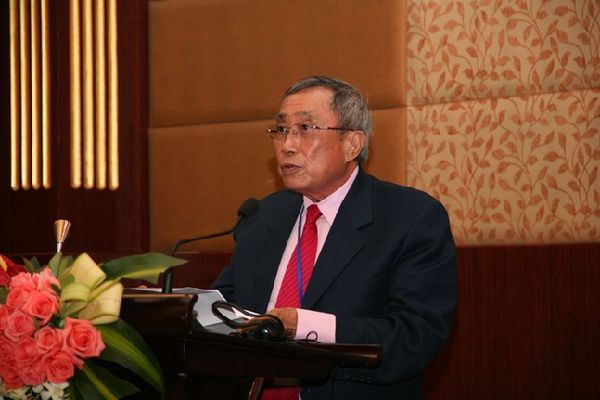The China dream and peaceful development
 0 Comment(s)
0 Comment(s) Print
Print E-mail China.org.cn, December 6, 2013
E-mail China.org.cn, December 6, 2013
|
|
|
Jusuf Wanandi. [File photo] |
-- Jusuf Wanandi, Vice Chair, Boar of Trustees, CSIS Foundation
For centuries China had been the centre of human civilisation, and yet almost always defensive and inward looking. Except during the Ching Dynasty, which is Manchu and not Han, some regions adjacent to China had been incorporated.
China was contended with itself when the region recognized it as a big power. That changed when Western colonialism, starting with the Opium War, imposed on her to open up for trade including opium. And since then on many of China were invaded or occupied by foreign powers through wars or temporary occupation.
The struggle for China since then, even in the declining Ching Dynasty, was how to repel the West and Japan as colonizers and to retrieve all parts of China that had been occupied by those powers with the birth of PRC Mao managed to unify China in 1949. A Herculean task was faced by China during its nation building efforts to move the country again. After more than 35 years of national, especially economic development, under the leadership of Chairman Deng since1978 until he stepped down, the realization of the Chinese Dream to become a wealthy and powerful country at long last showed its concrete results.
Now, under Chairman and President Xi Jinping China can look forward to its dream to come true. The results of the Third Plenum of the 18th Central Committee Meeting are reform oriented, especially in responding to the new challenges China is facing for its better future.
In short, China is resolute to deal with:
- Social equity: equal treatment of migrant workers in urban areas or reform of the Hukou system;
- Market forces: giving the market a "decisive" role in setting prices;
- Social reform: freeing up land in rural parts the migrants left behind to become a boost for economic growth. Also, the gradual liberalization of the one child policy will be good for economic growth;
- Political reform: gradual process and not to adopt a Western liberal democracy. Mr. Xi abolished the forced labour penalty. He recognized the usefulness of NGOs and is open to have a partial independent court mechanism.
The dream of China is to become strong and wealthy country, and has a utilitarian purpose, and the reforms adopted in the Third Plenum are making headway to become a reality. It is going to double the per capita income by 2021 to US$12,000.00 at the centennial of the Party, and to become a developed economy in 2049 at the centennial of founding the PRC.
China is aware that these reforms will reap external reactions but it expects more positive than negative ones. China had done two things. Firstly, it agreed with the U.S to lay down new basis for big powers relationship: mutual respect, not to intervene in each other domestic issues, and cooperation based on a win-win principle. The new rules between the big powers hopefully will reduce tensions and prevent misunderstanding.
Secondly, it agreed that there is a need for China to rise or develop peacefully, and for that China should be able to create a community of interest between China and other countries, especially with her close neighbors.
Currently, war is no more an alternative, with the existence of nuclear weapons, while confrontation like in the Cold War does not help the global economic cooperation since it is still in a precarious situation in the medium term. Thus, the only positive alternative is to create a community of interest.
China's relations with ASEAN or Southeast Asia, which is considered as its closest neighbors, is among others defined by the problems arising from the South China Sea disputes. How China is going to create a common interest with ASEAN on the South China Sea issue is very critical. That is why we now agreed to establish CBMs through two efforts: the implementation of the Declaration of Conduct (DoC) for fisheries, environment, resources, and joint-development, and formulation of a Code of Conduct (CoC) to create a regional order to prevent conflict or manage it when conflict arises. It is not to solve the sovereignty problems between the claimants, which is theirs to solve bilaterally in the longer term. This cooperation consist of three layers, between governments (ASEAN + China), between 1.5 track efforts by forming an Eminent Persons and Experts Group (EPEG), and among think tanks. This is the way how we build an ASEAN-China common interest on the most important issue between the two.
The most difficult issue in the region now is the China-Japan relations in regards of the overlapping claims on Diaoyu or Senkaku islands group. The problem is the residue of World War II issues, and the historical part of the issues is complicated. That is why PM Abe revisionist statement on World War II and its impact does not help. Second, is on the U.S role which is not conducive to involve herself in the dispute between China and Japan despite her defence treaty with Japan.
Third, Deng Xiaoping was right when he argued about postponing the resolution of the claims, and go for a joint-development. But so much water has gone under the bridge which beg the question whether going back to his wisdom is no more possible.
What the region can do is to advise caution and restraint to both sides, because so much is at stake for East Asia's stability and development if tensions and conflict can flare up due to the fit for that policies on both sides. For both sides there is the needs to create immediately direct contact and mechanism to prevent misunderstanding especially among the military.







Go to Forum >>0 Comment(s)